Spanish Navy Marines
| Spanish Navy Marines Infantería de Marina | |
|---|---|
 Badge of the Spanish Navy Marine | |
| Active |
February 27, 1537 – present (479 years, 9 months) |
| Country |
|
| Branch |
|
| Type | Marines |
| Role | Amphibious Warfare |
| Size | 4,680 Marines |
| Garrison/HQ | San Fernando |
| Motto(s) |
"Per Terra et Mare" ("By Land and Sea!") |
| March | Marcha heroica de la Infantería de Marina |
| Anniversaries | February 27th |
| Engagements |
Battle of Lepanto War of Jenkins' Ear Siege of Pensacola Spanish–American War Rif War Spanish Civil War |
| Commanders | |
| Current commander | Major General Pablo Miguel Bermudo y de Espinosa |
The Spanish Navy Marines (Spanish: Infantería de Marina; lit, Naval infantry) is a corps within the Armada (as it is called the Spanish Navy in Spanish language) responsible for providing amphibious warfare from the sea utilizing naval platforms and resources. It is fully integrated into the Armada structure.
The Corps was formed in 1537 by Charles I of Spain (also known as Charles V, Holy Roman Emperor), making it the oldest marine corps in existence in the world, drawing from the Compañías Viejas del Mar de Nápoles.
Mission
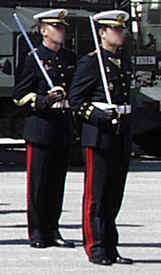
The Spanish Navy Marines is an elite corps, highly specialised in amphibious warfare, that is, to project an amphibious force onto a hostile, or potentially hostile, coast. Its ability to embark on a short term notice with (land, air and naval) Navy assets, makes it a unit with a high strategic value. Adding to this a high degree of training, and the capability to deploy swiftly in international waters, results in a potent dissuasive force available at a short notice in distant regions.
One of the main characteristics of a marine is the uniform that he wears. On the sleeves of the Spanish Marines are the three "Sardinetas", which marks it as a member of the Royal House Corps. This was given in recognition for a heroic last stand in the Castillo del Morro of Havana, Cuba against a British expedition in 1762. The only other unit to wear the sardinetas and red trouser stripes is the Spanish Royal Guard. Spanish Marines have modern assets to comply with its mission, having personnel specialised in artillery, sapping, helicopters, special operations, communications, tanks, among others. Some vehicles form the Grupo Mecanizado Anfibio del Tercio de Armada (the Mechanized Amphibious Group of the Navy Tercio).
The Marines of Spain are not only a fleet force, as the Spanish Royal Marine Guard Company are responsible for the defense and security forces of naval bases and facilities, naval schools and training units, and all facilities that support the Marines themselves.
The most famous Spanish Marine is without a doubt Miguel de Cervantes, author of the novel Don Quixote, who was wounded in the Battle of Lepanto in 1571. Another famous writer, Pedro Calderón de la Barca, also served with the marines.
History
First period

The Infantería de Armada (Navy Infantry) was created by Charles V in 1537, when he permanently assigned the Compañías Viejas del Mar de Nápoles (Naples Sea Old Companies) to the Escuadras de Galeras del Mediterráneo (Mediterranean Galley Squadrons). But it was Philip II who established today's concept of a landing force. This was a pure naval power projection ashore by forces deployed from ships that could maintain their ability to fight despite being based on board. This is the period of the famous Tercios (literally "One Third", due to its organisation: one third of musketeers, one third of spearmen and the final third of pikemen):
- Tercio Nuevo de la Mar de Nápoles.
- Tercio de la Armada del Mar Océano.
- Tercio de Galeras de Sicilia.
- Tercio Viejo del Mar Océano y de Infantería Napolitana.
Of the Tercios above, the first is considered the core of the Spanish Navy Marines, and it bears in its coat of arms two crossed anchors that became the Corps' coat of arms until 1931.
In 1704, the Tercios became regiments: Regimientos de Bajeles (Vessel's Regiments), Regimiento de la Armada (Navy Regiment), R. del Mar de Nápoles (Naples' Sea Regiment), and R. de Marina de Sicilia (Sicily's Navy Regiment), detaching some small units to the Army, and the main body remained in the Navy becoming the Cuerpo de Batallones de Marina (Navy Battalions Corps).
The battles that the marines served in during this very busy period included:
- Algiers expedition (1541).
- Battle of Lepanto (1571).
- Tunisia expedition (1573).
- The conquest of Terceira Island (Azores) (1582).
- Great Britain expedition (1599).
- San Salvador (Brazil) expedition (1625).
Second period
In 1717 the Cuerpo de Batallones de Marina was definitively settled and organized, reaching its full strength of twelve battalions. The first ones were named: Armada, Bajeles, Marina, Oceano, Mediterráneo and Barlovento. Their mission was to form the "Main body of landing columns and ship's soldiers tasks" in a time that boarding was still a critical part of battle at sea. They were also gun crews.
In a 1793, a woman, Ana Maria de Soto, disguised as a man, and answering to the name of Antonio Maria de Soto, enlisted in the 6th company of 11° Battalion of the Navy, being licensed with pension and honors in 1798, when she was discovered to be a woman. She was the first female Marine of the world.
The major actions they took part in during this period were:
- Sardinia, 1717
- Naples and Sicily, 1732
- Battle of Cartagena de Indias, 1741
- Defence of Havana, 1762
- Algiers expedition, 1775
- Battle of Pensacola (1781)
- Siege of Toulon, 1793
- Defense of Ferrol, Spain, 1800
- Recapture of Buenos Aires, 1806
Third period
Though Spain's empire was dismembered in the nineteenth century the marines continued to be active abroad.
Its most important actions in this period were:
- Santo Domingo (1804)
- Cochinchina (Vietnam) (1858)
- Mexico (1862)
- Cuba and Philippines (1898)
- Morocco (1911)
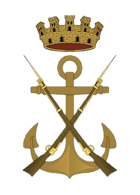

These actions were carried out by the Batallones Expedicionarios (Expeditionary Battalions), some of them campaigning abroad for up to ten years.
Fourth period
At the end of the World War I, the Battle of Gallipoli made almost all countries abandon the idea of amphibious assault. The world's marine corps fell into a deep crisis, with the Spanish Navy Marines being no exception, though it enjoyed success during the Third Rif War in its innovative Alhucemas amphibious assault in 1925, when it employed coordinated air and naval gunfire to support the assault.
Owing to its high-profile action in the unpopular Rif Wars, the Spanish Navy Marine corps was branded as a leftover of the Spanish colonial era. After the proclamation of the Second Spanish Republic in 1931, the reforms of the armed forces introduced by newly nominated Republican Minister of War Manuel Azaña within the first months of the new government sought to disband the corps.
Before it was officially disbanded, however, the Spanish Civil War intervened and the corps split and served both sides with the garrisons of Ferrol and Cádiz on the Nationalist side and the garrison of Cartagena, as well as a detachment in Madrid, on the Republican side. During the bitterly fought war the Marines performed garrison duties, led landing parties, and provided expert artillery and machine gun crews. The Republican 151 Brigada Mixta fought mostly inland battles far away from the sea. Photographer Robert Capa took pictures of the Spanish Republican Navy Marines in the Battle of the Segre.[1] Republican Infantería de Marina Lieutenant Colonel Ambrosio Ristori de la Cuadra, killed in action during the Siege of Madrid, was posthumously awarded the Laureate Plate of Madrid.[2]
Fifth period

After the civil war, during the dictatorship of Francisco Franco, the strength of the Infantería Marina was increased. In 1957, the Grupo Especial Anfibio (Amphibious Special Group) was created, and the Spanish Navy Marines returned to its primary duty as a Landing Force Mission. In 1958 it established a beachhead in Spanish Sahara and Ifni during the Ifni War. The capabilities and strength of the Spanish Navy Marines were increased: new amphibious vehicles, anti-tank weapons, individual equipment and artillery.
The Tercio de Armada (TeAr) became the main amphibious unit and has experienced several restructures that led to the E-01 Plan, which defines the requirements and structures from the year 2000 for the Spanish Navy Marines. The Spanish Marines have been present in Europe, Central America and Asia in an anonymous role as an "emergency force" ready to evacuate civilians in conflict areas, or as a deterrence force in providing cover for the actions of allied forces. The current base for the Spanish Marines is in San Fernando.
Today the main fighting Force of the Spanish Marine Infantry is the Marine Infantry Brigade, which includes the following units:
- Marine Infantry Brigade (BRIMAR)
- Headquarter Battalion, with 1x Headquarter, 1x Signals and 1x Military Intelligence Company.
- 1st Landing Battalion, with 1x HQ & Service, 3x Naval Fusiliers and 1x Weapons Company.
- 2nd Landing Battalion, with 1x HQ & Service, 3x Naval Fusiliers and 1x Weapons Company.
- 3rd Mechanized Landing Battalion, with 1x HQ & Service, 2x Mechanized (Piranha IIIC 8x8) and 1x Tank Company (M60 Patton)
- Reconnaissance Battalion, with 1x HQ & Service, 1x Reconnaissance and 1x Motorized Reconnaissance Company.
- Artillery Landing Group, with 1x HQ & Service, 2x Field Artillery (105mm Mod. 56), 1x Self-propelled Artillery (155mm M109A2) and 1x Air-Defense Artillery Battery (Mistral).
- Amphibious Mobility Group, with 1x HQ & Service, 1x Engineer, 2x Amphibious Assault Vehicle, 1x Anti-Tank (TOW), 1x Boat and 1x Beach Mobility & Support Company.
- Combat Service Support Group, with 1x HQ & Service, 1x Transport, 1x Medical, 1x Supply and 1x Maintenance Company.
Other Infantry units of the Spanish Navy are:
- Protection Forces (FUPRO)
- Tercio North (Northern Battalion)
- Tercio of Levante (Eastern Battalion)
- Tercio of the South (South Battalion)
- Canarias Security Unit
- Headquarters Security Group, Madrid
Ranks of the Navy Marines
Even through the ranks of the Navy Marines are similar to Spanish Army ranks they wear also sleeve and cuff insignia to recognize them as part of the naval establishment, aside from shoulder rank insignia.
Officer rank insignia
| NATO Code | OF-7 | OF-6 | OF-5 | OF-4 | OF-3 | OF-2 | OF-1 | ||
|---|---|---|---|---|---|---|---|---|---|
| Spain |
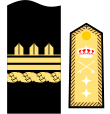 |
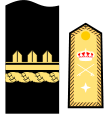 |
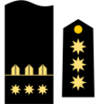 |
 |
 |
 |
 |
 | |
| General de División | General de Brigada | Coronel | Teniente Coronel | Comandante | Capitán | Teniente | Alférez | ||
Non-commissioned officers rank insignia
| Código OTAN | OR-9 | OR-8 | OR-7 | OR-6 | OR-5 | OR-4 | OR-3 | OR2 | OR1 | ||||||||||||||||||
|---|---|---|---|---|---|---|---|---|---|---|---|---|---|---|---|---|---|---|---|---|---|---|---|---|---|---|---|
| Spain |
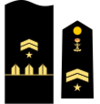 |
 |
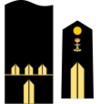 |
 |
 |
 |
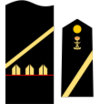 |
 |
 |
 | |||||||||||||||||
| Suboficial Mayor | Subteniente | Brigada | Sargento Primero | Sargento | Cabo Mayor | Cabo Primero | Cabo | Soldado de Primera | Soldado | ||||||||||||||||||
Student
| NATO Code | OF-D | Officers student | Sub-officers student | Recruit | |||||
|---|---|---|---|---|---|---|---|---|---|
| Spain |
 |
 |
 |
 |
 |
 |
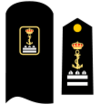 |
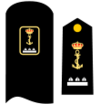 |
 |
| Alférez
(Alumno 5º) |
Guardiamarina de 2º
(Alumno 4º) |
Guardiamarina de 1º
(Alumno 3º) |
Aspirante de 2º
(Alumno 2º) |
Aspirante de 1º
(Alumno 1º) |
Sargento Alumno
3º año |
Alumno
2º año |
Alumno
1º año |
Aspirante MPTM | |
Battledress officers rank insignia
| NATO Code | OF-7 | OF-6 | OF-5 | OF-4 | OF-3 | OF-2 | OF-1 | |
|---|---|---|---|---|---|---|---|---|
| Spain |
 |
 |
 |
 |
 |
 |
 |
 |
| General de División | General de Brigada | Coronel | Teniente Coronel | Comandante | Capitán | Teniente | Alférez | |
Battledress non-commissioned officers rank insignia
| NATO Code | OR-9 | OR-8 | OR-7 | OR-6 | OR-5 | OR-4 | OR-3 | OR-2 | OR-1 | |||||||||||||||||||||||||||||
|---|---|---|---|---|---|---|---|---|---|---|---|---|---|---|---|---|---|---|---|---|---|---|---|---|---|---|---|---|---|---|---|---|---|---|---|---|---|---|
| Spain |
 |
 |
 |
 |
 |
 |
 |
 |
 |
 | ||||||||||||||||||||||||||||
| Suboficial Mayor | Subteniente | Brigada | Sargento Primero | Sargento | Cabo Mayor | Cabo Primero | Cabo | Soldado de Primera | Soldado | |||||||||||||||||||||||||||||
Other ranks
- Soldado – Private, Marine
- Soldado de Primera – Private First Class
- Cabo – Lance Corporal
- Cabo Primero – Corporal
- Cabo Mayor – Corporal Major/Lance Sergeant
- Sargento – Sergeant
- Sargento Primero – Staff Sergeant, Colour sergeant
- Brigada – Brigadier, Gunnery Sergeant
- Subteniente- Sublieutenant
- Suboficial Mayor – Sub-officer Major
Officer ranks
- Alumno – Officer Cadet
- Guardiamarina – Midshipman
- Alferez – Ensign
- Teniente – Lieutenant
- Capitan – Captain
- Comandante – Commandant, Commander, Major
- Teniente Coronel – Lieutenant Colonel
- Coronel – Colonel
- General de Brigada – Brigade General
- General de Division – Divisional General
The Spanish Marine's Decalogue
Original Spanish
- 1º mandamiento : Mi primer deber como infante de marina es estar permanentemente dispuesto a defender España y entregar si fuera preciso mi propia vida
- 2º mandamiento : Seré siempre respetuoso con mis mandos, leal con mis compañeros, generoso y sacrificado en mi trabajo
- 3º mandamiento : Estaré preparado para afrontar con valor abnegación y espíritu de servicio cualquier misión asiganada a la Infantería de Marina
- 4º mandamiento : Seré siempre respetuoso con las tradiciones del cuerpo, estaré orgulloso de su historia y nunca haré nada que pueda desprestigiar su nombre
- 5º mandamiento : Ajustaré mi conducta al respeto de las personas, su dignidad y derechos serán valores que guardaré y exigiré
- 6º mandamiento : Como Infante de marina la disciplina constituirá mi norma de actuación, la practicaré y exigiré en todos los cometidos que se me asignen
- 7º mandamiento : Como Infante de marina mi misión será sagrada en su cumplimiento venceré o moriré
- 8º mandamiento : Aumentar la preparación física y mental será mi objetivo permanente
- 9º mandamiento : Seré duro en la fatiga, bravo en el combate, nunca el desaliento en mi pecho anidará, nobleza y valentía serán mis emblemas
- 10º mandamiento : ¡Mi lema! … ¡Valiente por tierra y por mar!
English
- 1: As a Marine my first duty is to be constantly ready to defend Spain and give my life if necessary.
- 2: I shall be always loyal with my brothers, respectful with my superiors, generous and devoted to my task.
- 3: I shall be always ready to face with courage, dedication and spirit of service any mission assigned to the Spanish Marine Corps.
- 4: I shall be always respectful about the traditions of the Corps, be proud of its history and will never do anything that may adversely reflect on its name.
- 5: I shall guide my conduct with respect for people, their dignity and rights I shall guard.
- 6: As a Marine, discipline will be my standard of acting in all tasks assigned to me.
- 7: As a Marine, my mission is sacred in its fulfillment, I shall either win or die.
- 8: Improving my body and training my mind shall be my permanent goals.
- 9: I shall be strong on fatigue, brave in battle, discouragement shall never nest in my heart, for honor and courage are my banners.
- 10: My motto!: Braver in land and in the sea!
Equipment

Infantry weapons
Pistols
- Llama M82 (are being replaced)
- FN FNP-9 (are going to replace Llama M82)
- HK USP in "Compact" version (are going to replace Llama M82)
- SIG Sauer P230 (used by UOE)
Assault rifles
- Heckler & Koch G36 (E and KV versions)
Grenade launchers
Sniper rifles
Submachine guns
Machine guns
- FN Minimi (5,56 Nato, 7,62 Nato)
- CETME Ameli (replaced by FN minimi)
- Rheinmetall MG-3
- M2HB
- M60 machine gun
Anti-tank weapons
Artillery

Guided missiles
Vehicles
- 17 M-60A3 TTS
- 39 Piranha IIIC 8x8 (Electronic Warfare, Turret LANCE, Medical etc..)
- 19 AAV-7A (amphibious armoured personnel carrier)
- 124 Humvee (will be replaced for URO VAMTAC BN3)
See also
- Marine (military)
- Unidad de Operaciones Especiales (UOE)
- Alonso Pita da Veiga at the "Battle of Pavia" captured King Francis I of France (1513–1525)
- Miguel de Cervantes Spain's most famous Marine, injured at the Battle of Lepanto (1571), where the Spanish marines played a decisive part.
- Salve Marinera, Spanish Navy anthem. Some of its best versions are sung by choruses of the Infanteria de Marina
- Armada of Spain
- Spanish Republican Navy
References
- Notes
External links
| Wikimedia Commons has media related to Spanish Navy Marines. |
- Official site
- El Tercio de Armada (BRIMAR) (SP Marines Brigade)
- Spanish Marines History
- Spanish Marines Portal
- Salve marinera – Anthem (by the Chorus of Infanteria de Marina and Escuela Nacional de Marineria) and Video